10 Guards, 900 Inmates; Staff Shortages Have Plagued State Prisons
Slowing operations to a crawl, as inmates escaped, prisons locked down.

Green Bay Correctional Institution in Allouez, Wis., is shown on Jan. 19, 2024. The state’s prisons have become increasingly difficult to control, guards say, as basic operations have slowed to a crawl. (Taylor Glascock / for the New York Times)
This story was originally published by The New York Times and Wisconsin Watch.
The reporters examined staffing and payroll data and interviewed dozens of guards and inmates for this article, which is part of a series about the Wisconsin Department of Corrections by The New York Times’ Local Investigations Fellowship.
Wisconsin’s top prison official wrote to the governor in 2015 with a dire warning: The state prisons were dangerously understaffed, imperiling both guards and inmates.
Today, two of the state’s prisons have been in lockdown for months. Prison officials who initially blamed the restrictions on violent outbursts have since conceded that a shortage of guards has kept the lockdowns in place.
That should not have been a surprise. By the time the crisis began, the state had known for years that it was losing guards faster than it could replace them, an examination by The New York Times and Wisconsin Watch has found.
Almost half the jobs for guards at the state’s maximum-security prisons were unfilled in mid-2023, up from just 10% at the start of 2017, according to an analysis of Department of Corrections data. Overtime costs have skyrocketed, and so has the percentage of inexperienced officers in the workforce.
The lack of personnel drove prison officials to take extreme shortcuts in how they ran the facilities, interviews and records show. Even so, state leaders did not take significant steps to slow the hemorrhaging of guards until last year, long after the earliest problems were apparent.
Wisconsin’s struggle to staff its prisons is reflective of a crisis building across the country, as the job of prison guard, long seen as a stable position with generous benefits, has become increasingly undesirable. Working conditions deteriorated as the pandemic ravaged aging correctional facilities, and other entry-level jobs suddenly began offering higher wages. The number of people employed by state prisons fell in 2022 to its lowest point in more than two decades, according to U.S. census data.
A national review by The Marshall Project described how short staffing has changed nearly every aspect of prison life across the country. In Georgia, the staff was stretched so thin that no one noticed for five days that a man had died in his cell. A prisoner in Missouri pulled out his own teeth, one by one, because he could not see a dentist.
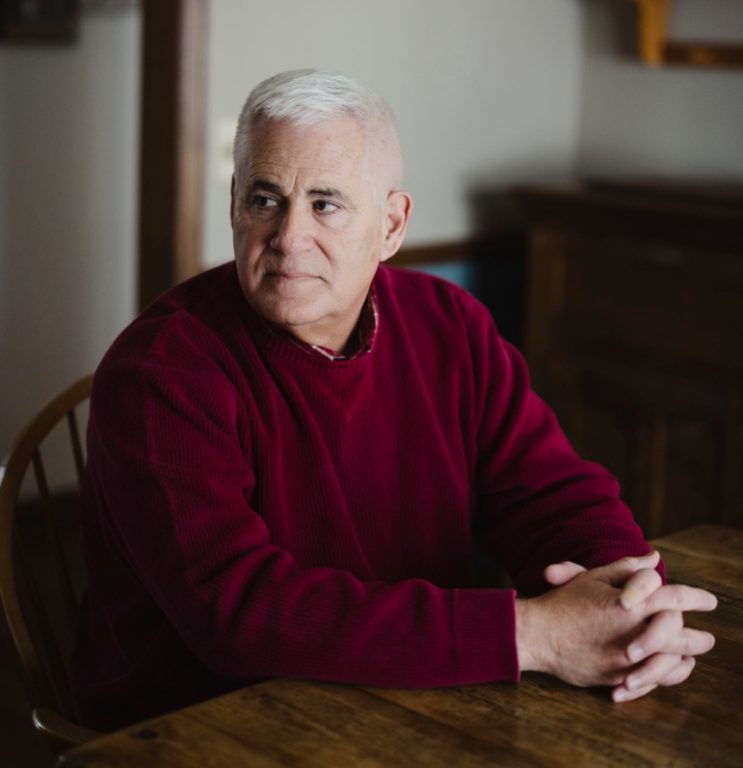
Ed Wall, who served as Wisconsin Department of Corrections secretary under Gov. Scott Walker from 2012 to 2016, is shown at his home in Windsor, Wis., on Jan. 18, 2024. In 2015, Wall saw staffing shortfalls as a brewing disaster. “The comment that we heard amongst staff all the time was that they’re not going to take us seriously until somebody gets killed,” he said. (Taylor Glascock / for the New York Times)
The state’s oldest prison, the Waupun Correctional Institution, has been locked down since March, with prisoners confined to their cells nearly all the time, eating meals out of brown paper bags and sometimes going weeks without fresh air and exercise. Inmates have been denied family visits, access to the law library and timely medical and dental care.
Prisoners say those conditions have driven many of them to think of suicide. One provided reporters with a prison report showing that on more than one occasion, guards had walked away while he cut himself. Three incarcerated men have died in Waupun since its lockdown began, including one confirmed suicide.
They described nights when 10 staff members at Waupun have been responsible for 900 prisoners; vans that no longer patrol another prison’s perimeter at night; teachers who set aside classroom duties to supervise inmates during recreation time.
Guards are now regularly required to work overtime; they are ordered at the end of a shift to stay at work for another, often with no warning, leaving family plans in upheaval. Some guards are made to work 16-hour days several times a week.
The Department of Corrections declined to comment for this article. In a statement this week, the department said that conditions in the locked-down prisons had improved and that it had hired nearly 300 new guards in November and December. In total, the department has nearly 3,000 full-time positions for corrections officers.
Last year, the Republican-controlled Legislature approved significant raises for guards, which have begun to reduce the number of unfilled openings. The move came two years after a similar proposal died amid partisan infighting, leading the percentage of unfilled openings at the state’s maximum-security institutions to climb sharply, exceeding 50% at four of the six prisons.
Gov. Tony Evers, a Democrat who was in office when that happened, acknowledged the staffing crisis in a recent interview. He said the raises for guards were helping and expressed regret that they did not extend to other corrections employees, like nurses and teachers.
“The pay makes a difference,” he said.
Overworked staff and angry prisoners
When Joe Verdegan was hired as a corrections officer at the Green Bay Correctional Institution in the 1990s, the benefits were good, the hours predictable, and the work manageable. There was a waiting list of applicants, he remembers, and the prison pretty much ran itself.
“When you got hired there, you were set for life,” Verdegan said.
That has changed tremendously over the past decade, he and other current and former guards said.
The first big shift came around 2011, when Scott Walker, the Republican governor at the time, signed Act 10, a sweeping law that gutted public employees’ ability to bargain collectively with the state, a step Walker said was needed to close a $3.6 billion budget gap.
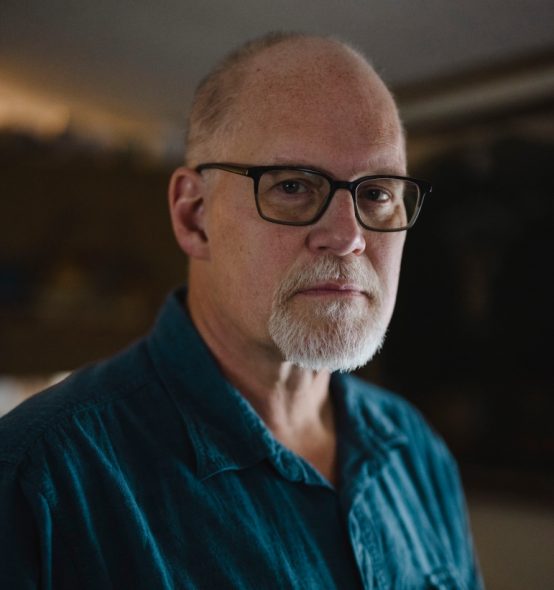
Former corrections officer Joe Verdegan is shown at his home in Dunbar, Wis., on Jan. 19, 2024. Verdegan, who retired from Green Bay Correctional Institution in 2020, says lockdowns were a familiar tool for managing prisoner populations. He recalls prison officials attributing a lockdown to inmate misbehavior when the real reason was that they lacked enough guards. (Taylor Glascock / for the New York Times)
The law broke most of Wisconsin’s powerful public-sector unions. Guards lost the ability to negotiate for better working conditions. Take-home pay shrunk because workers had to contribute more to pay for their benefits. A record number of state employees retired the year the law took effect. The employees who remained were forced to cover for them, often through mandatory overtime.
Veteran officers began to lose prized seniority rights, like the ability to choose preferred shifts and work assignments, according to Jeff Hoffman, who worked as a corrections officer at Green Bay until he retired in 2023. Schedules were even more grueling for the newest hires.
“They were getting jammed every single day, working 16-hour days, week after week after week, until they quit,” Hoffman recalled.
Between 2013 and 2022, annual overtime pay for officers and sergeants more than doubled, to $64.8 million from $28.1 million, according to an analysis of state payroll data.
The high levels of overtime resulted in at least 714 officers and sergeants — roughly one out of every six guards and sergeants — being paid more than $100,000 in 2022. Twenty-eight of them made more than the $152,755 salary of the head of the department.
The ballooning costs reflected the Legislature’s decision to prioritize overtime ahead of increasing pay to attract new hires, said Ed Wall, who led the Department of Corrections from 2012 to 2016.
In 2015, Wall saw the staffing shortfalls as a brewing disaster and wrote a memo to Walker to warn him.
“If we don’t address the recruitment and retention issues appropriately, we will continue to see OT escalate and fatigue get worse,” he wrote, adding that overworked guards and angry prisoners were a recipe for trouble.
He said he handed it to Walker’s chief of staff. It never came up again.
The view in the department, Wall said in a recent interview, was, “They’re not going to take us seriously until somebody gets killed.”
Wall resigned in 2016, during a federal investigation into allegations of abuse at a youth prison in northern Wisconsin, and he was later fired from a civil service position over allegations that he tried to evade the state’s open records law. Wall has said he was a scapegoat and that his ouster was politically motivated.
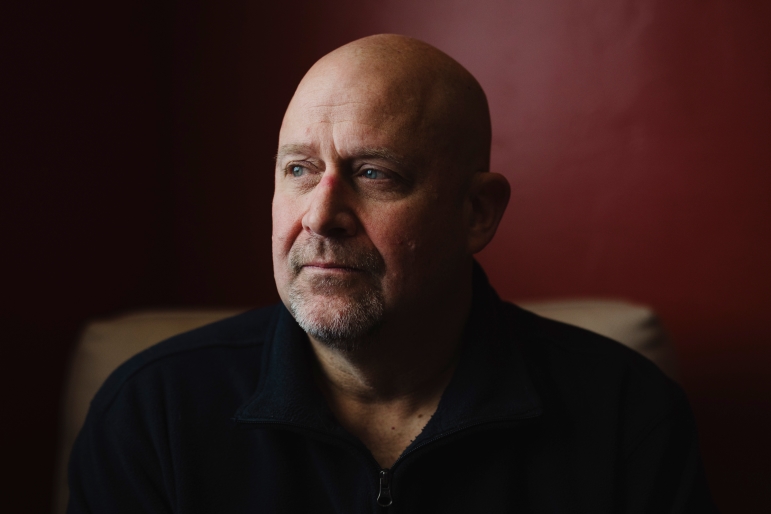
Jeff Hoffman, who retired as a Green Bay Correctional Institution corrections officer in 2023, is shown at his home in Green Bay, Wis., on Jan. 20, 2024. He says Act 10, a 2011 law that gutted most public employees’ collective bargaining rights, upended life for corrections officers. (Taylor Glascock / for the New York Times)
Walker did not respond to a request for an interview about Wall’s memorandum.
In a statement, Walker said: “State government leaders in Wisconsin can look at recruiting efforts, higher pay, and — most importantly — greater certainty with scheduling to help address the staffing issues in the Department of Corrections. Our Act 10 reforms do not have an impact on any of these issues.”
In 2020, the pandemic threw the prison system into chaos. In April of that year, two men with violent histories escaped from Columbia Correctional Institution, a maximum-security prison north of Madison, where four out of the five guard towers were unmanned.
A Corrections Department spokesperson denied that short staffing played a role in the security lapse, though he also said that towers at all of the state’s prisons have been closed on overnight shifts as a result of budget cuts.
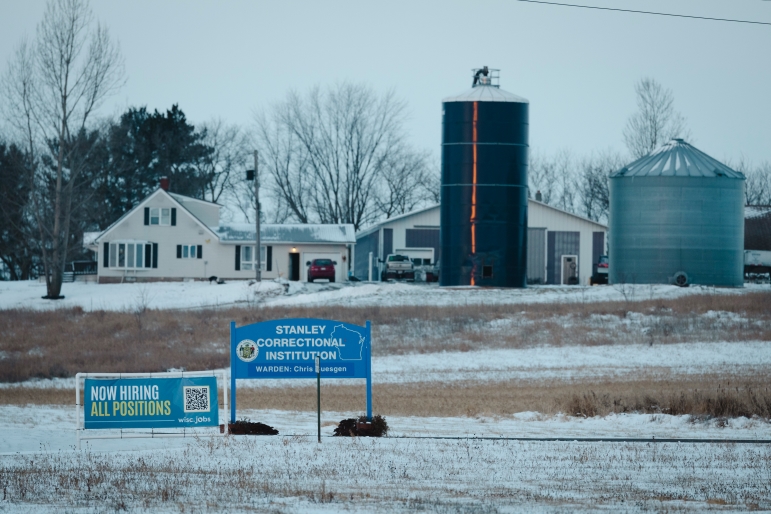
A sign advertises job openings outside the Stanley Correctional Institution in Stanley, Wis., on Jan. 19, 2024. Almost half the jobs for guards at Wisconsin’s maximum-security prisons were unfilled in mid-2023, according to an analysis of Department of Corrections data. (Taylor Glascock / for the New York Times)
A plan to raise wages
In 2021, the Department of Corrections asked a state legislative committee to take a major step to stabilize the prison system: A $5-an-hour pay bump for corrections officers and sergeants, with extra pay available for workers at maximum-security prisons.
In testimony and letters to the legislative committee, guard after guard said their facilities were in dire crises.
One young officer, Lucas Meier, said a colleague was beaten unconscious by an inmate. The assault stopped because “the inmate, frankly, got tired,” he said.
George Kraemer, a sergeant at Dodge Correctional Institution, an intake facility, described one overnight shift in 2021 when a single guard had to monitor 144 inmates in two separate barracks-style dormitories — leaving 72 prisoners unsupervised at any given time.
The legislative committee approved modest across-the-board raises for all state employees, but voted 6-2 against extra pay for guards, with Republicans on the committee opposing it. The Legislature instead voted to give the guards extra pay using short-term federal pandemic money — which Evers then vetoed, saying it was irresponsible financing and the money was needed elsewhere.
More corrections officers left. The vacancy rate at one prison reached 67%.
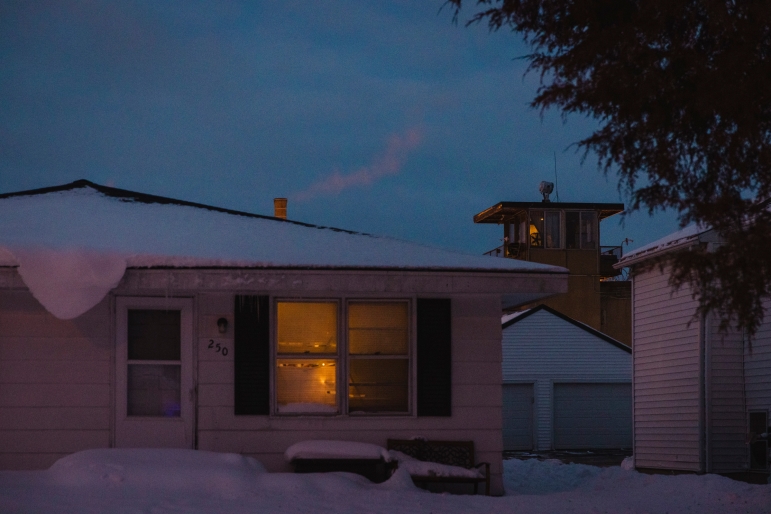
The Green Bay Correctional Institution in Allouez, Wis., remains on lockdown. One of its towers is seen from a neighboring residential street on Jan. 19, 2024. (Taylor Glascock / for the New York Times)
At least three prisons were placed on lockdown. All had severe guard shortages, the staffing data revealed. One — the Stanley Correctional Institution, a medium-security prison in western Wisconsin — had the state’s highest ratio of inmates to guards: nearly 20 inmates for every guard in May 2023. Two years earlier, the ratio was about 8 to 1. Stanley remained on lockdown for a year.
Verdegan, who retired from the Green Bay prison in 2020, said he often saw prison officials attribute a lockdown to inmate misbehavior, when too few guards was the real reason.
As the situation in the prisons worsened, the calls to raise guards’ pay started to receive support from Republicans. In 2023, the Legislature agreed to raise starting pay for corrections officers to $33 an hour from $20.29 and made additional pay available to those working at maximum-security prisons and facilities with vacancy rates above 40%.
Vacancy rates for guards finally started declining. Restrictions have been eased at some facilities, including the Stanley prison, where family visits and recreation were restored. Still, two prisons remain on lockdown, and prisoners have said in recent weeks that life in those facilities has barely improved since the lockdowns started.
Evers said the pay increases helped attract an especially large class of recruits. Corrections officers said they were cautiously optimistic, but that it might take a year or two for the new wave of recruits to make much difference in the staffing shortages. One reason: The department has historically lost about half of all new recruits in their early years of service.
Jack Kelly contributed reporting.
Mario Koran is examining the Wisconsin Department of Corrections as part of The New York Times’ Local Investigations Fellowship. This article was reported in partnership with Wisconsin Watch and Big Local News at Stanford University and with support from the Data-Driven Reporting Project.


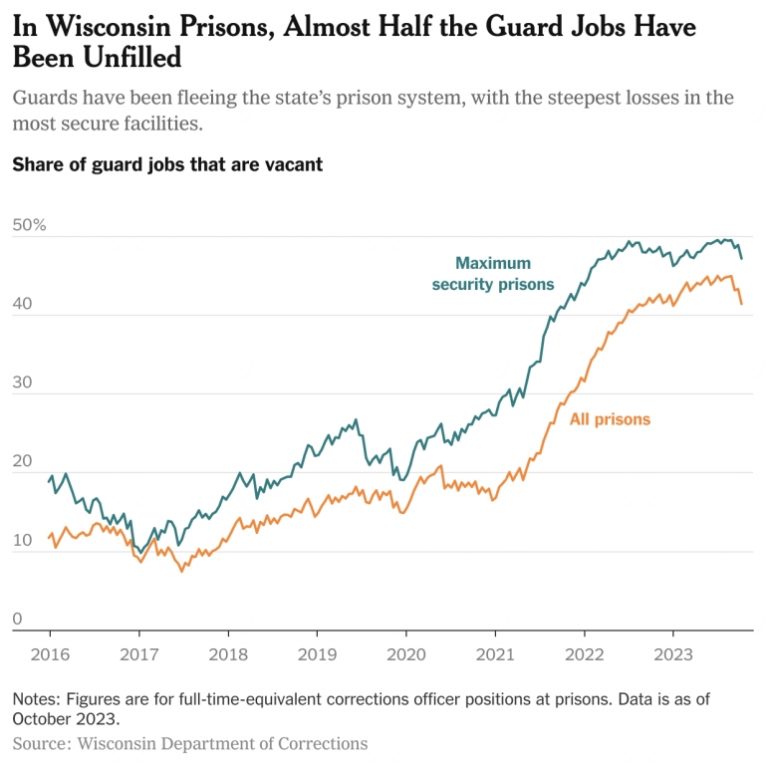
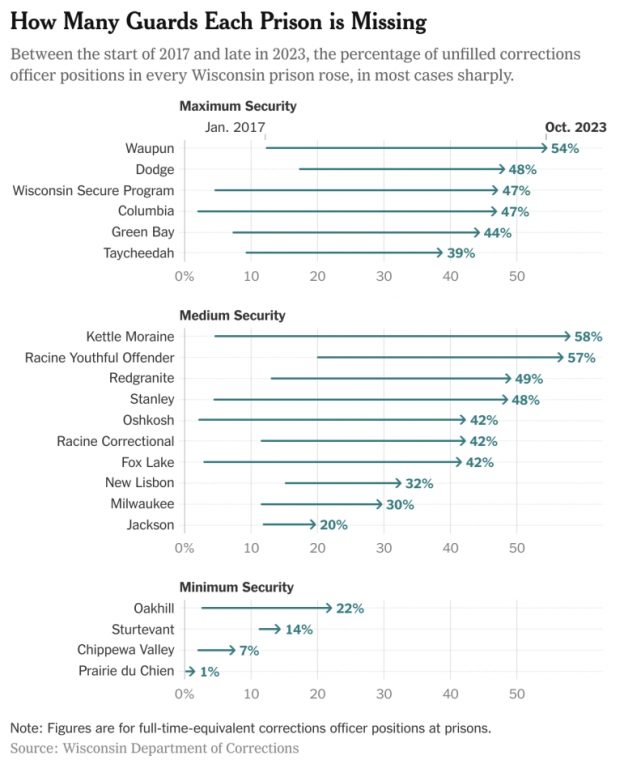


















I’m a retired Social Worker and Substance Abuse Counselor. I witnessed this & more first hand. I worked for a non-profit Halfway House for Men on Supervision. It was contracted by DOC.
I’m also member of MICAH & WISDOM, Intetfaith organizations seeking justice for the incarcerated & on Supervision with Ex Prisoners Organizing. (EXPO).
Former Gov Walker used his position to ramp-up his Presidential run.
Act 10 caused this crisis among others.
Walker also shut down releasing Inmates to Community Supervision (formerly Parole).
The WI dominated Republican Legislators changed laws to increase prison sentences. causing Mass Incarceration. WI has the highest rate of incarceration in the U.S.!
Structural & Institutional Racism have increased over the past 40-50 years. It parallels Civil Rights losses.
Racial profiling, especially in Milwaukee, disproportionately arrested Black & Brown Citizens.
Most were entrapped by undercover Officers for selling small amounts of Marijuana. While Whites use & sell Marijuana at the same rate.
The Dept of Corrections’ (DOC) Community Supervision Agents (formerly P.O.s) act as predators treating Black Men as prey. Agent’s add additional rules on top of the standard 16.
“Offenders” as DOC officially calls them, are sent back to prison without committing a crime! Without Due Process! They broke a supervision rule.
Tremendous damage continues to impact families, the community and the Inmate.
Prison Lockdowns, Short-staffing create a desperate atmosphere, ripe for chaos.
GOP legislators & DOCs’ culture caused the crisis and must be held responsible for correcting it
We lock up too many people.
We underfund State Public Defender.
We lock up the wrong people.
We underfund the prison system we overload.
We then lock down prisons making life hell.
The public surely needs protection. But from people like
trump, vos, tiffany and their ilk more than some poor
schmoe who sells drugs to people who want them.
Wisconsin has a tax surplus of approximately $6 billion. This seems like an appropriate place to direct some of that monsy.
Summed up perfectly BigRed81